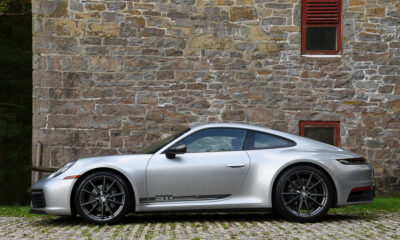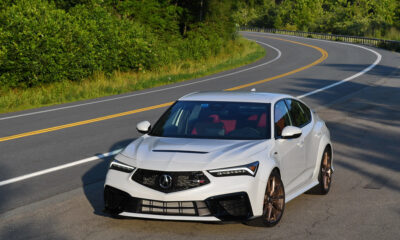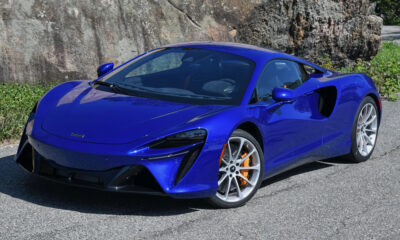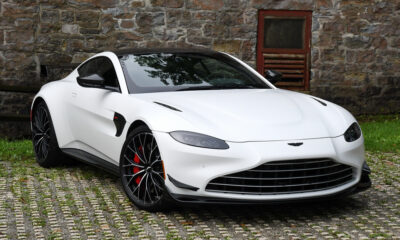
Photo: John Dagys
When you think of performance cars, Porsche is undoubtably one of the manufacturers that immediately comes to mind. The German automaker, in its 75 years of producing high-end sports cars, has delivered some of the industry’s pure classics, both for the road and race track.
Three years ago, Porsche took the bold step into the electric vehicle market with its Taycan, the production version of the highly-touted Mission E concept car that was first unveiled at the 2015 Frankfurt Motor Show.
The Taycan set a new benchmark, in not only delivering an industry leading high-performance car but creating an EV that’s quintessentially a Porsche.
In our recent test drive of a 2022 model year Taycan GTS during the IMSA event at Watkins Glen International, it was clear that we were at the wheel of a Porsche, first and foremost. From the moment you step into the car, there are clear cues that this isn’t just any EV.
From the 911-inspired steering wheel to its signature rounded instrument cluster that’s been transformed into a curved 16.8-inch screen, the interior showcases both Porsche’s heritage and next-generation design alike.
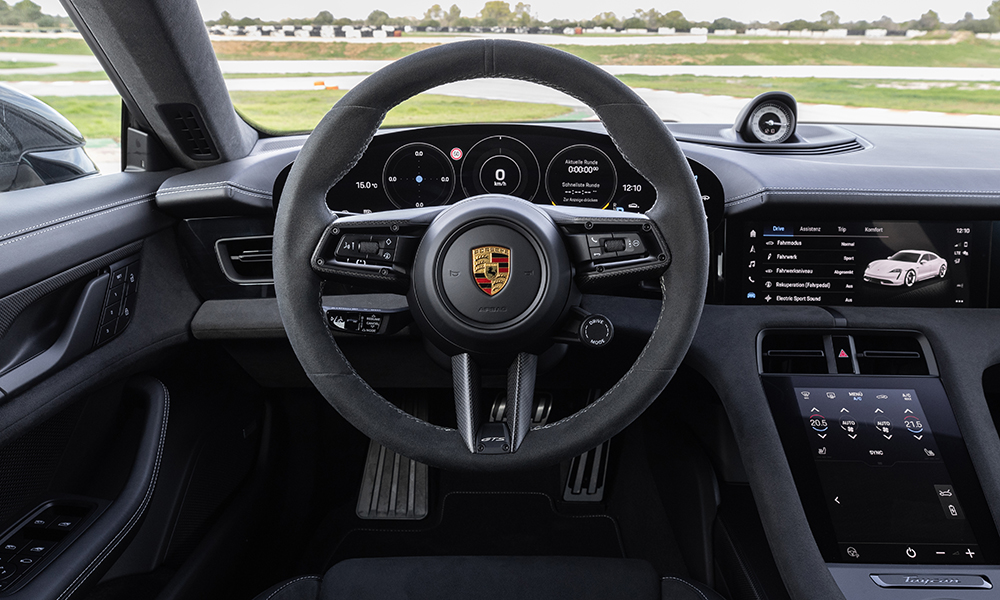
Photo: Porsche
A central 10.9-inch infotainment display and 8.4-inch touch panel with haptic feedback serves as the control center for the Taycan, with an intuitive user interface that runs everything from cabin climate to user-controllable ride height adjustments and chassis stiffness.
While wireless Apple CarPlay and Android Auto comes standard, an update rolled out earlier this year allows for EV routing in Apple Maps, an extremely handy feature that’s activated through the My Porsche app, which we were unable to get fully functional.
The somewhat-glitchy app may have been the only disappointment from our test drive, with all other systems, including Porsche’s InnoDrive driver assistance interface that includes active lane keeping assist and adaptive cruise control, performing flawlessly, especially on the four-hour drive from Newark to the finger lakes region of New York.
In terms of performance, the Taycan GTS does not disappoint. Featuring up to 440 kW (590 horsepower) through a dual motor, all-wheel drive configuration, the car can go from 0-60 mph in a mind-blowing 3.5 seconds while in launch control mode and at a top speed of 155 mph.
A flick of the switch to Sport or Sport Plus modes from a dial on the steering wheel instantly provides more power and puts the car into a much more pronounced form, that once again, feels like a Porsche. Other modes include Normal, Range and Individual, the latter which can be customized to the user’s specific settings.
 Photo: John Dagys
Photo: John Dagys
Another key feature that shouldn’t be overlooked is a two-speed automatic transmission at the rear-axle, a first for a production EV, which was implemented to improve both acceleration and efficiency at higher speeds.
Unlike other EVs such as Teslas that have limited configurations, the Taycan’s plethora of options can be a bit mind-numbing. What’s important is to understand the differences in power and range.
The base Taycan, with a single rear-wheel-driven motor, producing 240 kW (320 hp) and equipped with a singe-layer 79.2 kWh base battery, starts at $90,900 USD but is rated for a range of 206 miles.
Upgrading to the larger 93.4 kWh battery not only gets an increased range of 246 miles but makes use of the car’s 800-volt charging architecture that allows for a peak charging rate of 270 kilowatts. Models with the larger battery can charge from 5 to 80 percent of its capacity in just over 20 minutes at a such-equipped DC fast charger.
The Taycan GTS is considered Porsche’s mid-range model for its all-electric platform, with a starting price of $139,300 USD. Our press car, loaded up with options such as 21-inch RS Spyder design wheels, rear axle steering, and a $1,130 passenger touchscreen display, retails for $161,970, representing a more realistic price, although the top-of-the-line Taycan Turbo S (Turbo as a trim, not a turbocharger) can be priced in excess of $200,000.
Additionally, Porsche offers the Cross Turismo and Sport Turismo variants as well, which allows for additional luggage space and increased ride height. These can be considered more practical options or for those wanting to have a vehicle that’s also capable of light off-road usage.
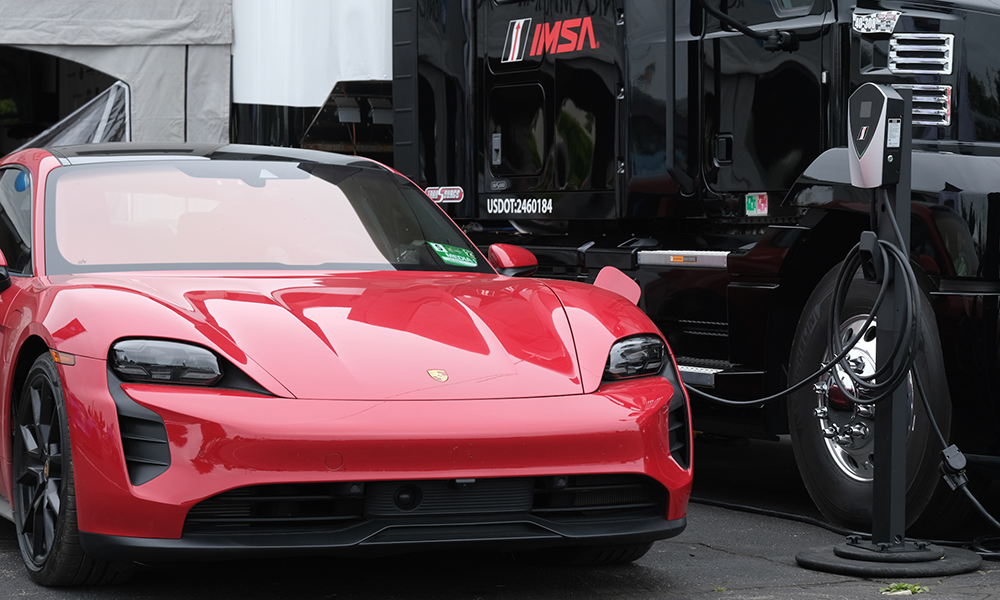
Photo: John Dagys
While range anxiety with the Taycan is typically not a thing, especially those models outfitted with the two-deck ‘Performance Battery Plus’ that comes standard on the GTS, having a consistent charging source, especially for extended road trips through rural areas where race tracks are commonly located, can certainly be a major benefit.
That’s why we graciously took advantage of IMSA’s trackside mobile charging solution while at Watkins Glen, given the lack of available charging options between the track and our hotel, some 40 minutes away, in Ithaca, N.Y.
Having debuted on the sanctioning body’s Konica Minolta business center unit at this year’s Rolex 24 Daytona in January, the state-of-the-art Level 2 charging system feeds off solar panels that were installed on the roof of the transporter. Excess energy, meanwhile, is stored in batteries and can also power the unit itself, as it did for 36 hours continuously at the Daytona event.
According to David Pettit, IMSA’s senior vice president of marketing and business operations, the solution allows for IMSA to charge EV and plug-in hybrid vehicles for OEM partners to be used on-site for hot laps, media events, product launches and official safety vehicles.
In our use with the system, we found peak charging speeds at 8.5 kilowatts, which refilled the Taycan’s battery in the matter of a few hours, which was extremely useful given our long days at the track. Plus, it provided a unique backdrop, with the Taycan GTS charging alongside Porsche’s GT4 e-Performance race car concept that was taking part in demo laps that weekend.
With Porsche embracing the future of electrified racing, it’s great to see its partners such as IMSA also supporting the OEM’s initiative, both on the track and on the road, as Porsche has rightfully done for the last three quarters of a century.

Photo: John Dagys

















